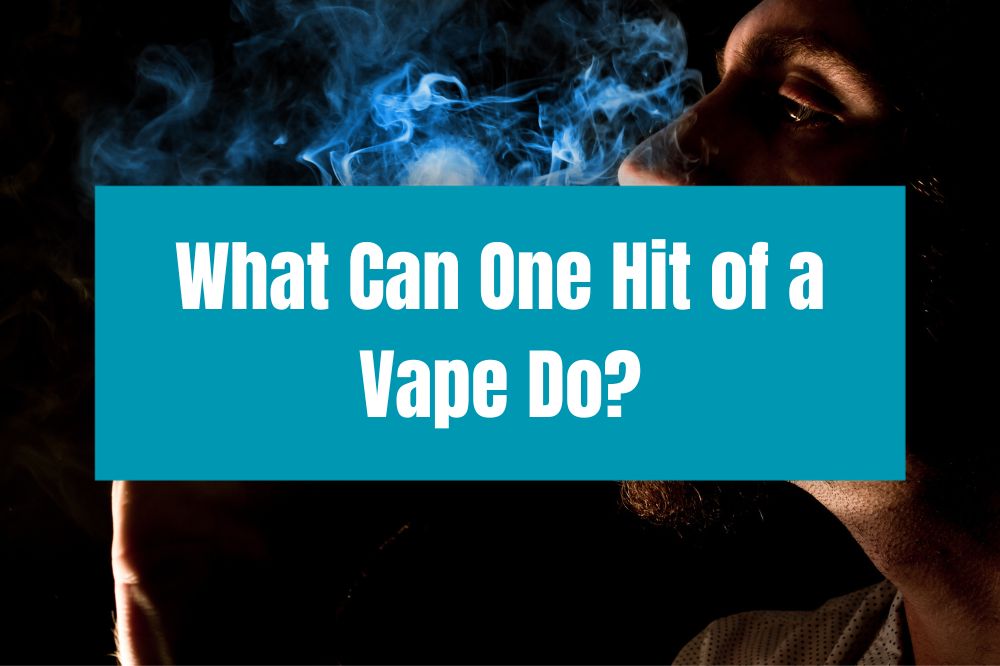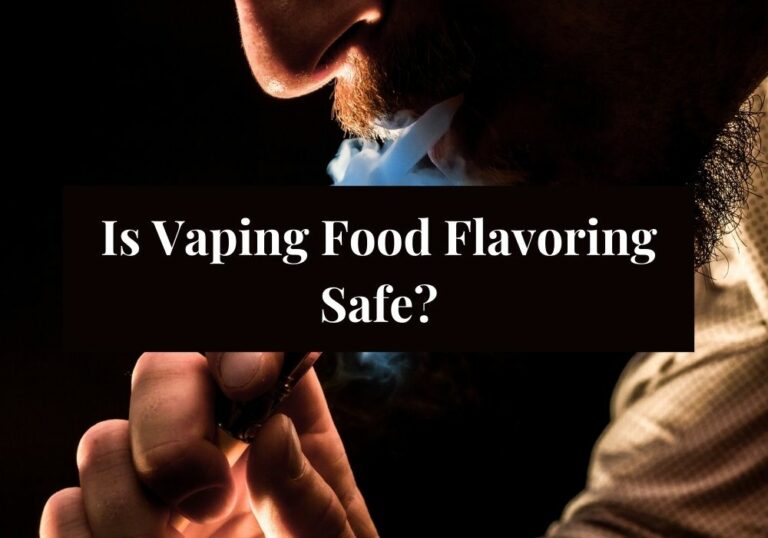What Can One Hit of a Vape Do?

If you’re considering trying vaping, you may be wondering what can happen if you take just one hit. While vaping is often marketed as a safer alternative to smoking, the truth is that it can still pose serious health risks. In fact, inhaling just one puff from a vape can cause damage to your lungs and heart.
Vaping involves inhaling an aerosol that is produced by heating up a liquid, which usually contains nicotine, flavorings, and other chemicals. When you take a hit from a vape, the aerosol enters your lungs and can cause irritation and inflammation. This can lead to symptoms such as coughing, wheezing, and shortness of breath. In some cases, vaping can even cause lung damage that is similar to the damage caused by smoking cigarettes.
Additionally, vaping can also have an immediate impact on your heart health. The nicotine in e-liquid quickly enters your bloodstream and can cause your body to release adrenaline, which can increase your heart rate, blood pressure, and breathing rate. This can potentially increase your risk of having a heart attack or other cardiovascular problems. So, while it may be tempting to try vaping, it’s important to understand the potential risks before taking that first hit.
Understanding Vaping
Vaping refers to inhaling and exhaling the vapor produced by an electronic cigarette or other similar device. These devices heat a liquid, often called e-juice or vape juice, which usually contains nicotine, flavorings, and other chemicals. The liquid is then heated to create a vapor that can be inhaled.
Vaping has become increasingly popular in recent years, particularly among young people. Many people believe that vaping is less harmful than smoking traditional cigarettes, but this is not necessarily true. While vaping may be less harmful than smoking, it is not without risks.
One of the main risks associated with vaping is the potential for lung damage. Vaping has oily liquids in its makeup and can cause lipoid pneumonia and inflammatory lung issues. The risks seem to far outweigh the benefits involved in vaping. Vaping-associated lung injury is a real consequence of inhaling the hot aerosol.
Another risk associated with vaping is addiction. Many vape juices contain nicotine, which is highly addictive. Nicotine can also have negative effects on the developing brains of young people.
Overall, while vaping may seem like a safer alternative to smoking traditional cigarettes, it is not without risks. It is important to understand the potential risks associated with vaping before deciding to start vaping.
Immediate Effects of One Hit
Taking just one hit from a vape can have immediate effects on your body. Here are some of the potential effects:
- Blood vessels and circulation: Research conducted at the University of Pennsylvania found that even just one puff of a vape can cause an immediate change in your body’s blood vessels and circulation, even if there is no nicotine present. This can affect your overall cardiovascular health.
- Lungs: Vaping can cause irritation and inflammation in your lungs, which can lead to coughing, wheezing, and shortness of breath. This can be especially dangerous for those with pre-existing lung conditions.
- Mouth and throat: Vaping can cause dry mouth and throat irritation, which can lead to soreness, hoarseness, and difficulty swallowing.
- Brain: Vaping can affect your brain function, including your ability to concentrate and your mood. This is because vaping can alter the levels of neurotransmitters in your brain.
It’s important to note that the effects of vaping can vary depending on the individual and the type of vape being used. However, even one hit can have negative consequences on your health.
Physical Impact
One hit of a vape can have a significant physical impact on your body. The effects can vary depending on the type of vape liquid, the amount of nicotine, and the frequency of use. Here are some of the physical impacts that one hit of a vape can have on your body:
Increased Heart Rate
The nicotine in vape liquid can cause an increase in heart rate, leading to a rapid heartbeat. This can cause feelings of dizziness or lightheadedness, which can be dangerous if you are driving or operating heavy machinery.
Lung Damage
Vaping can cause damage to your lungs, including inflammation and irritation. This can lead to coughing, wheezing, and shortness of breath. In some cases, vaping can cause more severe lung damage, including lung disease.
Increased Blood Pressure
Vaping can also cause an increase in blood pressure, which can lead to a higher risk of heart attack or stroke. This is particularly dangerous for people with pre-existing heart conditions.
Addiction
One hit of a vape can contain a high amount of nicotine, which can lead to addiction. Nicotine is highly addictive, and it can be difficult to quit once you become addicted. This can lead to a lifetime of health problems and a decreased quality of life.
Organ Damage
Vaping can cause damage to your organs, including your liver, kidneys, and lungs. This can lead to long-term health problems and a decreased lifespan.
Overall, one hit of a vape can have a significant physical impact on your body. It is important to understand the risks associated with vaping and to make an informed decision about whether or not to use these products.
Mental Impact
One hit of a vape can have an impact on your mental health. Vaping has been linked to various mental health issues, including depression, anxiety, and mood disorders.
According to a study by Truth Initiative, frequent vaping is tied to higher odds of having a diagnosis of depression compared to never users. The study also showed that current and former e-cigarette users had higher odds of reporting anxiety and mood disorders.
Nicotine, the addictive substance in vapes, can also affect your brain’s reward system, leading to changes in mood and behavior. This can make it harder to quit vaping and lead to increased cravings and withdrawal symptoms.
In addition to nicotine, vapes can contain potentially harmful substances, including heavy metals and ultrafine particles that can cause lung damage. The impact on mental health has been overshadowed by concerns about physical health, but it is important to consider both when weighing the risks of vaping.
If you are experiencing mental health issues, it is important to seek help from a healthcare professional. Quitting vaping can also have a positive impact on your mental health and overall well-being.
Potential Risks
Taking one hit from a vape may seem harmless, but it can have potential risks. Here are some of the risks associated with vaping:
- Addiction: Vaping products contain nicotine, which is highly addictive. Nicotine can alter your brain chemistry and make you crave more. Even one hit can be enough to trigger addiction in some people.
- Lung damage: Vaping can cause lung damage, including inflammation and irritation. Some vaping products contain harmful chemicals that can damage your lungs and cause respiratory problems. According to a doctor’s warning about the dangers of vaping from Mayo Clinic Health System, vaping can lead to chronic obstructive pulmonary disease (COPD) and other lung diseases.
- Heart problems: Vaping can also cause heart problems. According to Johns Hopkins Medicine, vaping can increase your risk of heart attack and other cardiovascular diseases.
- Exposure to harmful chemicals: Vaping products can contain harmful chemicals, including heavy metals and carcinogens. A study by Johns Hopkins Medicine found that some vaping products contained potentially harmful substances, including a pesticide and two flavorings linked with possible toxic effects and respiratory irritation.
- Gateway to other drugs: Vaping can be a gateway to other drugs, including conventional cigarettes. According to the National Institute on Drug Abuse (NIDA), teens who vape are more likely to try other tobacco products.
In conclusion, taking one hit from a vape may seem harmless, but it can have potential risks. Vaping can lead to addiction, lung damage, heart problems, exposure to harmful chemicals, and can be a gateway to other drugs. It’s important to be aware of these risks and make informed decisions about vaping.
Long-Term Consequences
While the short-term consequences of vaping are concerning, the long-term consequences are even more alarming. One hit of a vape can lead to long-term health problems that can affect you for the rest of your life.
Addiction
One of the most significant long-term consequences of vaping is addiction. Vaping devices contain high levels of nicotine, which is highly addictive. Nicotine addiction can lead to a host of health problems, including heart disease, lung disease, and stroke.
Lung Damage
Vaping can cause long-term damage to your lungs. The chemicals in e-cigarette vapor can cause inflammation in your lungs, which can lead to chronic obstructive pulmonary disease (COPD) and other lung diseases. In addition, vaping can cause lung cancer, just like smoking tobacco.
Heart Disease
Vaping can also lead to long-term heart problems. The chemicals in e-cigarette vapor can cause damage to your blood vessels and increase your risk of heart disease. In addition, nicotine can cause your blood pressure to rise, which can put additional strain on your heart.
Brain Development
Vaping can also have long-term effects on brain development, especially in teens and young adults. Nicotine can interfere with brain development, which can lead to problems with attention, learning, and impulse control.
Conclusion
In conclusion, one hit of a vape can have long-term consequences that can affect your health for the rest of your life. Vaping can lead to addiction, lung damage, heart disease, and problems with brain development. It’s important to understand the risks of vaping and to avoid using e-cigarettes altogether.
The Role of Nicotine
When you take a hit from a vape, you are inhaling a mixture of chemicals, including nicotine. Nicotine is a highly addictive substance that is found in all tobacco products, including e-cigarettes. According to Scientific American, after a few puffs of a burning cigarette, a smoker’s lungs will be filled with nicotine.
Nicotine can have a range of effects on your body. It can increase your heart rate, constrict your blood vessels, and raise your blood pressure. As a result, vaping can cause shortness of breath, chest pain, and even heart attacks in some people.
Moreover, nicotine can also affect your brain and mood. It can stimulate the release of dopamine, a neurotransmitter that is associated with pleasure and reward. This can give you a temporary feeling of pleasure and relaxation, but it can also lead to addiction.
It is worth noting that the amount of nicotine in a single hit of a vape can vary widely depending on the device, the e-liquid, and the way you inhale. Some e-cigarettes can deliver a higher concentration of nicotine than a traditional cigarette, while others may contain little to no nicotine at all.
In summary, nicotine plays a significant role in the effects of vaping, both on your body and your brain. While it may give you a temporary feeling of pleasure, it can also lead to addiction and have harmful effects on your health.
Impact on Youth
Vaping is a serious health concern for youth. According to a study published in the National Library of Medicine, youth electronic cigarette use has risen significantly over the past decade. Vaping can cause physical and behavioral health complications in young people. Here are some of the impacts of vaping on youth:
- Nicotine addiction: Vaping devices, such as e-cigarettes, contain nicotine, which is highly addictive. Youth who vape can quickly become addicted to nicotine, leading to long-term health problems.
- Lung damage: Vaping can cause lung damage, including asthma and bronchitis. A study by Utah State University found that youth vaping is related to lung illnesses and is associated with an increased severity of these infections.
- Intensive care unit (ICU) admissions: Patients with e-cigarette injuries admitted to hospitals are often put in the ICU. A study by Utah State University found that 55% of patients with e-cigarette injuries admitted to 13 different hospitals were put in the ICU.
- Cannabis use: Vaping has already progressed from nicotine to marijuana in many adolescents. Vaping cannabis oil can also stimulate the release of dopamine in the brain, leading to addiction.
It is important to educate youth about the negative impacts of vaping and provide them with resources to quit if they have already started. Parents can also play a crucial role in preventing youth vaping by being involved and talking to their children about the dangers of vaping.
Impact on Non-Smokers
If you are a non-smoker, taking one hit from a vape can still have harmful effects on your health. The chemicals used in vaping, aside from nicotine or THC, such as flavorants and other chemicals, can be super harmful to your heart and lungs. Inhaling these chemicals, even in small amounts, can cause irritation and inflammation in your lungs, leading to breathing difficulties and other respiratory problems.
According to a study published in August 2021, even a single session of vaping without nicotine can hurt your lungs. The study found that 31 nonsmoking participants between the ages of 18 and 35 vaped the equivalent of one conventional cigarette, and the solution used in the experiment contained no nicotine. The results showed that the participants experienced a significant increase in inflammatory markers in their lungs, which can lead to serious respiratory problems over time.
Moreover, the aerosols produced by vaping devices contain several compounds that are not present in e-liquids, and the device material also seems to contribute to the presence of metal and silicate particles in the aerosols. These particles can cause damage to your lungs and other organs over time, leading to serious health problems.
In summary, taking one hit from a vape, even if it is just flavored vapor, can have harmful effects on your health. If you are a non-smoker, it is best to avoid vaping altogether to protect your respiratory health.
Vaping vs Traditional Smoking
When it comes to the effects on your health, vaping and traditional smoking are not equal. While both involve inhaling substances into your lungs, the way they do it and the chemicals involved are different.
Traditional smoking involves burning tobacco, which releases thousands of harmful chemicals, including tar, carbon monoxide, and formaldehyde. These chemicals can damage your lungs, increase your risk of cancer and heart disease, and cause other health problems.
Vaping, on the other hand, involves heating a liquid (often containing nicotine) to create an aerosol that you inhale. While vaping does still expose you to some harmful chemicals, it is generally considered to be less harmful than traditional smoking.
According to Johns Hopkins Medicine, vaping is less harmful than smoking, but it’s still not safe. E-cigarettes heat nicotine (extracted from tobacco), flavorings, and other chemicals to create an aerosol that you inhale. Regular tobacco cigarettes contain 7,000 chemicals, many of which are toxic.
However, it’s important to note that the long-term effects of vaping are still not fully understood. Some studies have suggested that vaping can cause lung damage, increase your risk of heart disease, and lead to other health problems.
Overall, while vaping may be a less harmful alternative to traditional smoking, it’s still important to be aware of the potential risks and make informed choices about your health.
Understanding Vape Products
If you are new to vaping, it is important to understand the different types of vape products available in the market. Vaping involves heating a substance, such as cannabis or nicotine, until it turns into vapor. Here are some common types of vape products:
- Vape pens: These are small, portable devices that use a cartridge filled with e-liquid, which is heated and turned into vapor. Vape pens are popular among beginners because they are easy to use and discreet.
- Box mods: These are larger, more powerful devices that allow users to customize their vaping experience. Box mods have a larger battery and can produce more vapor than vape pens.
- Pod vapes: These are similar to vape pens but use a disposable pod filled with e-liquid. Pod vapes are often marketed as a simpler alternative to vape pens.
When it comes to vaping, it is important to choose high-quality products from reputable manufacturers. Poor-quality vape products can be dangerous and lead to health problems. Always read reviews and do your research before purchasing a vape product.
It is also important to understand the ingredients in your vape products. E-liquids used in vape products typically contain nicotine, flavorings, and other chemicals. Some e-liquids may also contain cannabis or CBD. Make sure to read the label and understand what you are inhaling.
Overall, understanding the different types of vape products and the ingredients they contain is essential for a safe and enjoyable vaping experience.
Regulations and Legalities
When it comes to vaping, there are a variety of regulations and legalities that you should be aware of. These laws can vary from state to state, so it’s important to do your research before you vape.
One important law to be aware of is the minimum age requirement for purchasing vaping products. While federal law allows 18-year-olds to purchase tobacco products, some states have put the minimum age at 21. For example, in California, Hawaii, New Jersey, and Oregon, you must be 21 to purchase vaping products.
Another important law to be aware of is the ban on flavored vaping products. Some states have implemented a statewide flavor ban, which prohibits the sale of flavored vape products. For example, in New York, all flavored vape products have been banned since May 2020. It’s important to check the laws in your state to ensure that you are not breaking any regulations.
Additionally, the FDA has issued regulations regarding the delivery and sales of electronic nicotine delivery systems (ENDS), which include e-cigarettes and vapes. Since 2016, the FDA has issued more than 8,000 warning letters to retailers for violating these regulations.
It’s important to follow these regulations and legalities to ensure that you are not breaking the law. Not only can breaking these laws result in fines and legal trouble, but it can also be harmful to your health.
Myths and Misconceptions
There are many myths and misconceptions surrounding vaping that can lead to confusion and misinformation. Here are a few common ones:
- Myth: Vaping is just water vapor. This is not true. Vaping involves heating a liquid that usually contains nicotine, flavorings, and other chemicals. When this liquid is heated, it creates an aerosol that you inhale. This aerosol is not just water vapor, but a mixture of chemicals that can be harmful to your health.
- Myth: Vaping is just as harmful as smoking. While vaping is not risk-free, it is generally considered to be less harmful than smoking. According to the NHS, vaping poses a small fraction of the risks of smoking in the short and medium-term. However, it is important to note that the long-term effects of vaping are not yet known.
- Myth: Vaping is a safe way to stop smoking. While vaping may be less harmful than smoking, it is not a safe way to stop smoking. Nicotine is still addictive, and there are still risks associated with vaping. Additionally, some studies have suggested that vaping may actually make it harder to quit smoking in the long run.
- Myth: Vaping is not addictive. This is not true. Vaping liquids usually contain nicotine, which is highly addictive. In fact, some vaping liquids contain even higher levels of nicotine than traditional cigarettes.
- Myth: Vaping is harmless to bystanders. This is not true. The aerosol produced by vaping can contain harmful chemicals that can be harmful to bystanders. Additionally, some studies have suggested that secondhand exposure to vaping aerosol can cause respiratory problems.
It is important to be aware of these myths and misconceptions surrounding vaping so that you can make informed decisions about your health. If you have any questions or concerns about vaping, it is always a good idea to talk to your healthcare provider.








